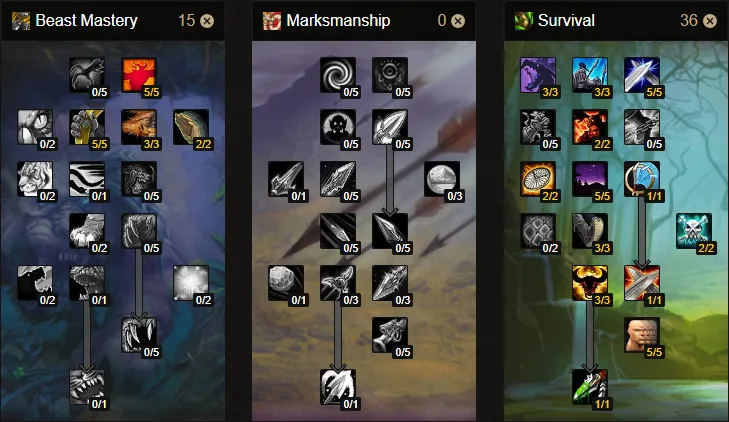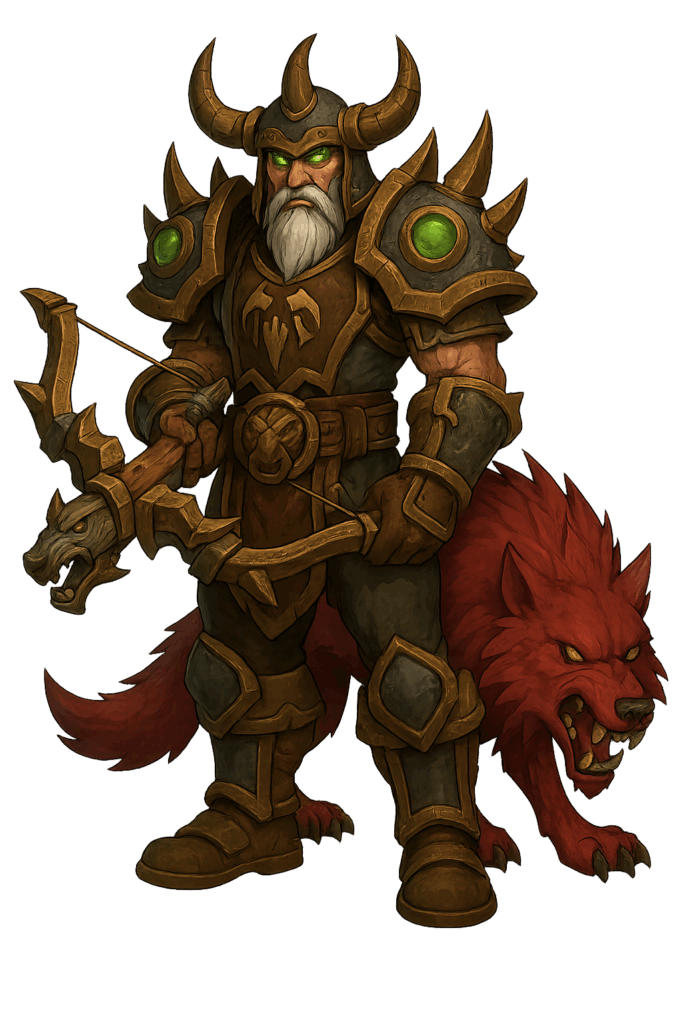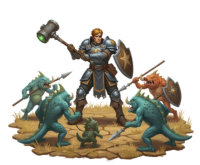Welcome to the ultimate WoW Classic Survival Hunter PvE guide for WoW Classic. While most hunters stick to ranged combat with Marksmanship or Beast Mastery, Survival Hunters break the mold by diving into melee range with axes, swords, and raw aggression. This spec transforms you from a traditional ranged damage dealer into a unique melee hybrid that thrives on dodging attacks and striking back with devastating counterattacks.
What Makes Survival Hunter Unique in PvE?
Survival Hunter stands apart as Classic’s only melee hunter specialization. Instead of maintaining distance and firing arrows, you’ll charge into combat alongside your pet, wielding melee weapons and turning defensive mechanics into offensive opportunities. Your core damage abilities—Mongoose Bite and Counterattack—only activate after successfully dodging or parrying enemy attacks, creating an entirely different playstyle from traditional hunter specs.
Understanding the Melee Hunter Playstyle
This specialization excels in scenarios where you can actively tank or offtank additional enemies. Every dodge triggers Mongoose Bite, while every parry enables Counterattack. This reactive combat style makes Survival incredibly engaging but situationally dependent. You won’t top damage meters on single-target boss fights, but when adds spawn or you can safely take hits, your damage potential spikes dramatically.
Best Races for Survival Hunter in WoW Classic
Horde Race Recommendations for Survival Hunter
Orc (Best Choice) 🏆
Orcs dominate as Survival Hunters thanks to three powerful synergies. Command increases pet damage by 5%, Axe Specialization grants +5 weapon skill when using axes (crucial for avoiding glancing blows), and Blood Fury provides +25% melee Attack Power for 25 seconds every 2 minutes. Blood Fury alone makes orcs exceptional for this melee-focused spec.
Troll (Strong Alternative)
Trolls offer Bow Specialization for passive ranged bonuses and Berserking for attack speed increases. While excellent for Marksmanship Hunters, trolls lose some value in Survival since you’ll primarily attack in melee. Still a solid choice, just outshined by orcs.
Tauren (Playable)
Taurens bring Endurance for extra health and War Stomp for an AoE stun. Unfortunately, they have the lowest base Agility of any race, which directly impacts your melee attack power and dodge chance. The defensive benefits don’t compensate for the offensive loss.
Alliance Race Recommendations for Survival Hunter
Dwarf (Best Choice) 🏆
Dwarves remain the top Alliance option with Gun Specialization providing passive benefits even in melee combat, plus Stoneform for removing bleeds, poisons, and diseases while boosting armor. The defensive utility helps you survive when tanking adds.
Night Elf (Competitive)
Night Elves boast the highest base Agility in the game and gain +1% dodge from Quickness. Since dodging directly enables Mongoose Bite, this passive has real value. However, the opportunity to dodge attacks in raids is limited, making Dwarf’s consistent benefits slightly better overall.
Survival Hunter Talent Build for PvE (15/0/36)
Important Note: You’ll use Aspect of the Monkey instead of Aspect of the Hawk. This is counterintuitive for most hunters but essential for Survival since dodging enables your strongest abilities.
Survival Hunter Stat Priority Guide for PvE
Survival Hunter stats differ dramatically from Beast Mastery or Marksmanship specs since you scale with melee stats instead of ranged attack power.
Optimal Stat Priority for Survival Hunter DPS
1. Hit Rating (8% Cap)
Reach 8% hit chance to eliminate misses on Raptor Strike and melee auto-attacks. Fortunately, Surefooted grants 3% hit, and you can get 2% from enchants, meaning you only need 3% from gear. This is your first priority—nothing else matters if your attacks miss.
2. Agility
Agility grants 1 melee Attack Power per point (same as Strength) but also increases critical strike chance and dodge percentage. This makes every point of Agility more valuable than Strength. Stack this aggressively after hitting the hit cap.
3. Strength / Attack Power
These stats are functionally identical for Survival Hunters. Strength converts 1:1 into melee Attack Power. Prioritize raw stats on gear that provide both Agility and Strength for maximum impact.
4. Dodge & Parry Rating
Here’s where Survival gets interesting. Defensive stats become offensive stats because dodging enables Mongoose Bite and parrying enables Counterattack. In fights with multiple enemies attacking you, these stats dramatically increase your damage output while keeping you alive.
5. Critical Strike Rating
Crit is less valuable than you’d expect due to talent synergies. Savage Strikes already grants +20% crit chance to Raptor Strike and Mongoose Bite, and Killer Instinct provides another +3% baseline. You’ll naturally achieve high crit rates without heavily investing in crit gear.
6. Intellect
Mana management is easier for Survival since you have fewer abilities to cast. Intellect provides a mana cushion for longer encounters but shouldn’t be prioritized over primary offensive stats.
Why Weapon Skill Matters for Survival Hunter
Weapon skill determines how effectively you land attacks against higher-level enemies. Each point of weapon skill provides:
- 0.04% reduced miss chance
- 0.04% reduced chance for enemy to block
- 0.04% reduced chance for enemy to parry
- 0.04% reduced chance for enemy to dodge
- 0.04% increased critical strike chance
Aim for 305+ weapon skill when fighting level 63 bosses (raid bosses). This dramatically reduces glancing blows that cut your damage by 25-40%. Orc racial (Axe Specialization) makes this effortless when using axes.
Best Professions for Survival Hunter PvE
Top Profession Choices for Survival Hunter
Engineering (Mandatory) ⚙️
Engineering isn’t just good for Survival Hunters—it’s essential. Since your ability rotation has significant downtime, engineering bombs fill gaps perfectly. Dense Dynamite, Thorium Grenades, and Arcane Bombs provide consistent AoE damage without GCD conflicts. Additionally, Goblin Jumper Cables XL combined with Feign Death lets you resurrect allies mid-combat, adding crucial utility to offset Survival’s lower personal DPS.
Check out our WoW Classic Engineering Leveling Guide for all the details.
Mining (Pairs with Engineering)
If you’re running Engineering, Mining is the logical companion. You’ll farm all materials needed for bombs and gadgets, saving significant gold while keeping yourself stocked.
Check out our WoW Classic Mining Leveling Guide for all the details.
Alternative Profession Options
Leatherworking
Leatherworking lets you craft the Black Dragonscale set, providing excellent starter gear with heavy Agility focus. This gives you a solid foundation before collecting pre-raid BiS items.
Check out our WoW Classic Leatherworking Leveling Guide for all the details.
Skinning (Pairs with Leatherworking)
Farm leather for your Leatherworking needs. It won’t provide combat benefits, but self-sufficiency reduces costs.
Check out our WoW Classic Skinning Leveling Guide for all the details.
Best Enchants for PVE Survival Hunter in WoW Classic
Enchants optimize your melee damage output while maintaining the hit cap and boosting survivability. Each slot contributes to your overall effectiveness in PvE content.
Complete Survival Hunter Enchant Guide
| Slot | Best Enchant | Stats Provided |
|---|---|---|
| Helm | Falcon’s Call | +24 Ranged AP, +10 Stam, +1% Hit |
| Shoulders | Zandalar Signet of Might | +30 Attack Power |
| Cloak | Enchant Cloak – Lesser Agility | +3 Agility |
| Chest | Enchant Chest – Greater Stats | +4 All Stats |
| Bracers | Enchant Bracer – Superior Strength | +9 Strength |
| Gloves | Enchant Gloves – Superior Agility | +15 Agility |
| Legs | Falcon’s Call or Lesser Arcanum of Voracity | +24 Ranged AP / +8 Agility |
| Boots | Enchant Boots – Minor Speed or Greater Agility | Speed / +7 Agility |
| Melee Weapon | Enchant Weapon – Crusader | Proc: +100 Strength + heal |
| Ranged Weapon | Biznicks 247×128 Accurascope | +3% Hit (ranged only) |
Note: Falcon’s Call provides hit chance despite listing ranged Attack Power. The +1% hit applies to all attacks, making it valuable for reaching the 8% cap. Crusader enchant on your melee weapon provides massive burst potential when it procs.
Best Consumables for Survival Hunter PvE
Consumables separate dedicated Survival Hunters from casual players. Since the spec inherently deals less damage than pure DPS classes, maximizing consumables demonstrates commitment to your raid group.
Must-Have Consumables for Survival Hunter Raids
Elixir of the Mongoose 🧪
Grants +25 Agility and +2% critical strike chance for one hour. This is your primary elixir—always have it active.
Juju Power
Provides +30 Strength for 30 minutes. Stacks with other buffs.
Juju Might
Grants +40 Attack Power for 10 minutes. Use liberally during boss encounters.
Smoked Desert Dumplings
Food buff granting +20 Strength for 30 minutes. Alternative: Grilled Squid for +10 Agility.
Situational Consumables for Maximum DPS
Major Mana Potion
Restores ~1,800 mana on a 2-minute cooldown. Keep these stocked for progression content.
Mageblood Potion
Grants +12 MP5 for one hour. Useful for sustained mana regeneration in longer fights.
Winterfall Firewater
Provides +35 Attack Power for 20 minutes but requires Winterfall Furbolg reputation farming. Worth the effort for serious progression.
Scrolls
Scroll of Agility IV (+17 Agility) or Scroll of Strength IV (+17 Strength) provide solid stat boosts for progression attempts.
Survival Hunter Rotation and Gameplay for PvE
Survival Hunter gameplay splits into two distinct scenarios based on whether you’re actively taking damage.
Basic Survival Hunter Rotation (No Damage Taken)
When you can’t safely take hits or dodge/parry mechanics aren’t available:
- Raptor Strike (on cooldown)
- Wing Clip (on cooldown)
- Auto-attack (primary damage source)
- Engineering Bombs (fill downtime)
This rotation is extremely simple because you lack access to reactive abilities. Auto-attacks comprise 60-70% of your damage in these scenarios.
Advanced Survival Hunter Rotation (Taking Damage)
When tanking adds or in situations where enemies attack you directly:
- Raptor Strike (highest priority)
- Mongoose Bite (if available after dodge)
- Counterattack (if available after parry)
- Wing Clip (filler)
- Auto-attack (continuous)
- Engineering Bombs (on cooldown)
Ability Priority Explanation: Raptor Strike deals the most damage and has Savage Strikes (+20% crit) built in. Mongoose Bite deals substantial damage and costs only 10 focus, making it efficient. Counterattack deals moderate damage but immobilizes the target. Wing Clip is pure filler when nothing else is available.
How to Use Survival Hunter Cooldowns Effectively
Deterrence (5-minute cooldown)
Increases dodge and parry by 25% for 10 seconds. This is both defensive and offensive—more dodges mean more Mongoose Bites, more parries mean more Counterattacks. Use it when you’re actively tanking adds for maximum damage and survivability.
Blood Fury (Orc racial, 2-minute cooldown)
Grants +25% melee Attack Power for 25 seconds. Try to synchronize with Deterrence for massive damage windows, but don’t delay it excessively—getting more uses throughout a fight is valuable.
Survival Hunter Threat Management in Raids
Unlike standard hunters who minimize threat, Survival Hunters often want threat on additional enemies. Use Distracting Shot to taunt adds when appropriate. Your pet should use Cower to drop aggro and let you tank, especially when you need to enable dodge/parry mechanics.
Best Pet for Survival Hunter in PvE Content
Your pet remains important as a Survival Hunter since you’re fighting alongside it rather than 40 yards away.
Best Pet Choice for Survival Hunter DPS
Wolf (Bloodaxe Worg) 🐺
Wolves are optimal due to Furious Howl, which increases physical damage on your next attack and your party members’ next attacks. Bloodaxe Worg from Lower Blackrock Spire has Rank 4 Furious Howl, the highest available in Classic.
Training Strategy: Tame Bloodaxe Worg to learn Rank 4 Furious Howl, then teach it to your permanent wolf. Bloodaxe Worg itself doesn’t have the best damage stats, so you’ll want to transfer the ability.
Pet Threat Considerations for Survival Hunters
Enable Cower on your pet unlike other hunter specs. Since you want enemies attacking you (to enable dodge/parry mechanics), your pet should actively drop aggro in many situations. This is counterintuitive for normal hunters but critical for Survival optimization.
Survival Hunter Raid Viability and Combat Role
Survival Hunter occupies a unique niche in raid environments. You’re not a primary DPS, nor are you a main tank—you’re a specialized offtank for handling additional enemies.
When Does Survival Hunter Excel in Raids? ✨
Multi-Target Encounters
Fights like Onyxia (whelp waves), Razorgore (adds), and trash pulls where multiple enemies need tanking showcase Survival’s strengths. Your ability to hold threat on several enemies while dealing competitive damage makes you valuable.
Add Management
Any encounter requiring add pickups benefits from a Survival Hunter. You can quickly grab loose enemies, tank them briefly, and leverage reactive damage abilities that other classes can’t access.
Survival Hunter Limitations in Single-Target Fights
Single-Target Boss Fights
Pure single-target encounters where the boss exclusively attacks the main tank render half your toolkit useless. Mongoose Bite and Counterattack never activate, leaving you with only Raptor Strike and Wing Clip. Your damage drops dramatically compared to other DPS specs.
Expectations Management
You won’t compete with Fury Warriors, Rogues, or even other hunter specs on damage meters. Set realistic expectations—your value comes from versatility, add management, and utility (combat resurrections with Goblin Jumper Cables XL).
Survival Hunter Pre-Raid Best in Slot (BiS) Gear
For detailed pre-raid BiS lists covering all three hunter specs, visit our comprehensive Hunter Pre-Raid BiS guide. Here are Survival-specific priorities:
Key Gear Targets for Survival Hunter
Weapons
- Melee: Aim for axes if playing Orc (Weapon Specialization). The Dal’Rend’s Tribal Guardian + Sacred Charge combo from UBRS is excellent.
- Ranged: Carapace Spine Crossbow (LBRS) or Strikers Mark (Dungeon 2 quest) maintain ranged attack options.
Armor Priorities
Focus on leather and mail pieces with high Agility, Strength, and Attack Power. The Black Dragonscale set from Leatherworking provides an excellent starter foundation.
Advanced Tips for Playing Survival Hunter in PvE
Maximizing Engineering Benefits
Keep a full stack of Dense Dynamite, Thorium Grenades, and Arcane Bombs. Use grenades on cooldown during encounters—they don’t share GCD with your melee abilities, making them pure DPS increases during rotation downtime.
Mastering Feign Death Mechanics
Master Feign Death interactions for combat resurrections. Drop combat with Feign Death, use Goblin Jumper Cables XL on a dead healer or tank, then re-enter combat. This can save wipes on progression content.
Aspect Dancing Strategy
While you primarily use Aspect of the Monkey in combat, swap to Aspect of the Hawk when moving between pulls or during ranged-only phases. Every bit of efficiency matters when playing an undertuned spec.
Using Tranquilizing Shot in Molten Core
Keep Tranquilizing Shot on your bars for Molten Core encounters. Magmadar and several other bosses gain Frenzy buffs that must be dispelled immediately. Being able to handle this mechanic adds tangible value to your raid spot.
Best Macros for Survival Hunter
Essential macros streamline your gameplay and increase efficiency. Check our dedicated Hunter Macros guide for a complete collection. Here are Survival-specific recommendations:
Melee Attack Macro
#showtooltip Raptor Strike
/startattack
/cast Raptor Strike
Ensures auto-attacks continue while using Raptor Strike.
Pet Attack + Furious Howl
#showtooltip Furious Howl
/petattack
/cast Furious Howl
Commands pet to attack and immediately use Furious Howl for maximum DPS.
Leveling as Survival Hunter Guide
While this guide focuses on PvE endgame content, leveling as Survival is viable if you enjoy the melee playstyle. For complete leveling guides covering all three specs, visit our Hunter Leveling hub or specifically the Survival Leveling guide.
Frequently Asked Questions (FAQ)
Is Survival Hunter viable in WoW Classic raids?
What's the best race for Survival Hunter in Classic?
Why use Aspect of the Monkey instead of Aspect of the Hawk?
Can Survival Hunter main tank in raids?
What weapons should Survival Hunters use?
How much hit rating does Survival Hunter need?
What's the difference between Survival and Beast Mastery Hunter?
Conclusion: Mastering Survival Hunter in WoW Classic
Survival Hunter in WoW Classic PvE offers a completely unique experience that rewards creativity, adaptability, and skilled play. While you won’t top damage meters on every fight, mastering this underdog spec brings satisfaction that pure meta picks can’t match. Your ability to handle adds, provide utility, and fill a hybrid offtank role makes you valuable in the right raid compositions.
Success as Survival comes from understanding your limitations, maximizing your strengths in appropriate situations, and demonstrating dedication through consumable preparation and mechanical execution. Embrace the melee hunter lifestyle—your raid might not expect much from you, but they’ll be impressed when you deliver.
For more hunter resources including talent calculators and specialization comparisons, check out our main WoW Classic Hunter Guide. Good hunting! 🏹⚔️
 World of Warcraft Guides, Lore, Addons & News – Noob to Boss From Azeroth's Newbie to Champion – World of Warcraft Guides
World of Warcraft Guides, Lore, Addons & News – Noob to Boss From Azeroth's Newbie to Champion – World of Warcraft Guides






